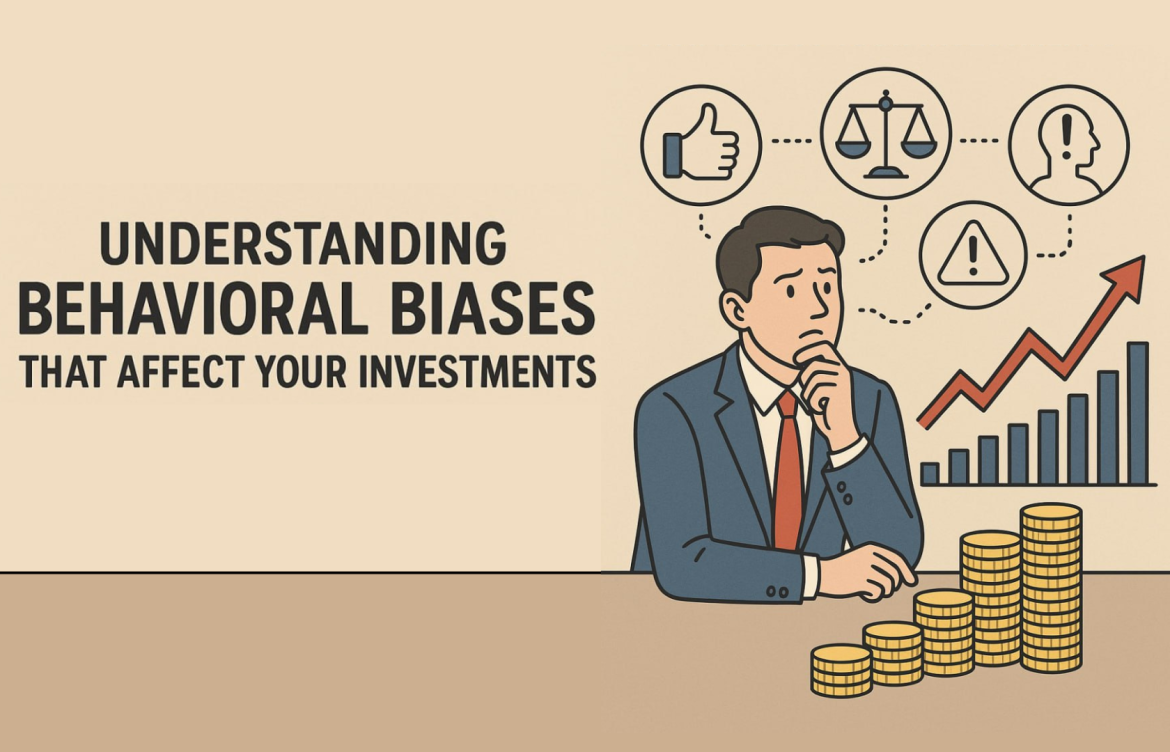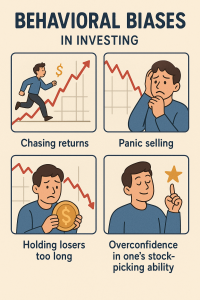
Understanding Behavioral Biases That Affect Your Investments
Understanding Behavioral Biases That Affect Your Investments
Ever wondered why you sell in panic during a market crash or hold onto a losing stock hoping it will bounce back? The truth is—investing is as much about psychology as it is about numbers.
Thank you for reading this post, don't forget to subscribe!Behavioral biases can cloud our judgment, leading to poor financial decisions. Understanding these biases helps investors stay rational, avoid common pitfalls, and build a more disciplined investment strategy.
Let’s explore the most common behavioral biases that affect investing and how to counter them.
What Are Behavioral Biases?

Behavioral biases are systematic errors in thinking that influence our decisions. In investing, these biases often lead to:
- Chasing returns
- Panic selling
- Holding losers too long
- Overconfidence in one’s stock-picking ability
These biases stem from emotions like fear, greed, overconfidence, and regret, and they can derail even the most well-planned investment strategies.
Common Behavioral Biases in Investing
- Loss Aversion
- Investors fear losses more than they value gains.
- You’d feel more pain from losing ₹10,000 than joy from gaining ₹10,000.
- Impact: Leads to holding on to losing stocks too long or selling winners too early.
💡 Counter it: Focus on your long-term goals and remember that short-term losses are part of the journey.
- Herd Mentality
- Following the crowd without independent analysis.
- Buying because “everyone is buying” (think IPO frenzy or bull run hype).
- Impact: Can lead to market bubbles or buying at peak prices.
💡 Counter it: Stick to your financial plan and evaluate investments based on fundamentals, not trends.
- Confirmation Bias
- Seeking out information that supports your existing beliefs while ignoring opposing views.
- Example: Only reading positive news about a stock you own.
- Impact: Leads to overconfidence and poor decision-making.
💡 Counter it: Be open to differing opinions and conduct balanced research.
- Overconfidence Bias
- Believing you know more than you actually do.
- Frequent trading, excessive risk-taking.
- Impact: Underestimates risk, leads to portfolio imbalance.
💡 Counter it: Acknowledge the role of luck and randomness in market outcomes.
- Anchoring Bias
- Relying too heavily on the first piece of information (anchor).
- Example: Refusing to sell a stock bought at ₹100 even if it’s fairly valued now at ₹75.
- Impact: Prevents rational reassessment of investments.
💡 Counter it: Regularly evaluate investments based on current facts, not past prices.
- Recency Bias
- Giving more weight to recent events and ignoring long-term trends.
- Example: Assuming the market will keep rising just because it has in the last few months.
- Impact: Can lead to unrealistic expectations and poor timing.
💡 Counter it: Base decisions on long-term data, not just recent performance.
- Mental Accounting
- Treating money differently based on its source.
- Example: Taking higher risks with bonus money than regular savings.
- Impact: Leads to inconsistent investing behavior.
💡 Counter it: Treat all money with the same logic—towards achieving your financial goals.
Real-Life Example: The 2020 Market Crash
During the COVID-19 market crash, many investors sold their equity holdings in panic (loss aversion and herd mentality). Those who stayed invested or even increased their exposure saw significant gains in the recovery phase.
This highlights why emotional discipline and awareness of biases are key to successful investing.
How to Tame Behavioral Biases
✅ Create a Financial Plan
Define your goals, risk appetite, and asset allocation in advance.
✅ Automate Investments
Use SIPs to reduce emotional decision-making and benefit from rupee cost averaging.
✅ Rebalance Periodically
Maintain target asset allocation regardless of market noise.
✅ Seek a Trusted Advisor
An advisor can offer a neutral perspective and prevent you from reacting emotionally.
✅ Educate Yourself
The more you understand about how markets work, the less likely you are to panic or overreact.
The Cost of Biases
Behavioral mistakes often cost investors more than market volatility itself. According to studies, the average investor underperforms the market because of poorly timed decisions driven by emotion.
Avoiding these mistakes is just as important as picking the right stock or mutual fund.
Conclusion
Behavioral biases are natural—but they don’t have to control your investing journey. By being aware of these psychological traps and adopting a disciplined approach, you can invest smarter, stay calm through market cycles, and stick to your long-term plan.
In investing, your mindset matters just as much as your money.
Need Help Staying Disciplined?
At Goodwill Wealth Management, we help investors build emotion-proof portfolios through goal-based planning, rational asset allocation, and periodic reviews.
Talk to our experts today to create a long-term strategy that keeps behavioral biases in check—and your wealth on track.

